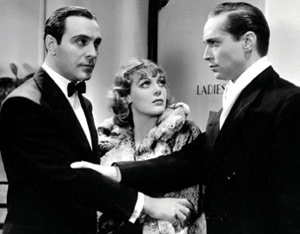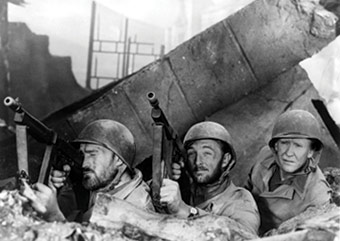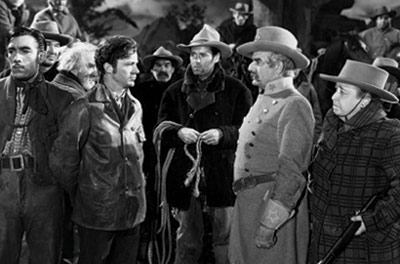BY GARY GIDDINS
 BATTLEGROUND (1949): Wellman on ladder. (Credit: Warner Bros.)
BATTLEGROUND (1949): Wellman on ladder. (Credit: Warner Bros.)
Few filmographies are more disorienting, at first blush, than that of William A. Wellman: so many titles you haven't seen, so many you've never heard of. But then your eyes focus more purposefully, and classics begin to leap from the list, suggesting not the work of one artist, but a team of fast and furious workmen, turning out crackling entertainments in every genre.
Had he made a dozen movies instead of nearly 80, Wellman's stature would likely be vastly enhanced. A culled list would include the unavoidable mobster classic The Public Enemy; pre-Code Depression landmarks like Night Nurse, Heroes for Sale, and Wild Boys of the Road (1931-33); the consummate, caustic inside-Hollywood tear-jerker, A Star Is Born (1937); the mocking and frequently hilarious newspaper sendups Nothing Sacred (1937) and Roxie Hart (1942); the innovative and heated Westerns The Ox-Bow Incident (1943), Westward the Women (1951), and Track of the Cat (1954); and two of the most credible films ever made about World War II, The Story of G.I. Joe (1945) and Battleground (1950).
Still, bring on those unknown or forgotten pictures. DVDs have mostly redounded to Wellman's credit, making available all the aforementioned films except Westward the Women, and the more we get to see of his work, the more surprises it holds, good and bad. He was a self-proclaimed man's man director who defined his personal story as that of a French Foreign legionnaire turned World War I fighter pilot (for the Lafayette Escadrille, before the United States entered the war). He was by all accounts leathery, curt, physically brave, quick to take umbrage, and happy to bear the sobriquets "Wild Bill" or, as he remarked in an interview, "sonofabitch." So he ought to have been at his best with material like the biographically mythic Buffalo Bill (1944) or the 1950s perils-of-aviation dramas Island in the Sky and The High and the Mighty, for which he was Oscar-nominated as director. Yet to say that these erstwhile hits do not wear well is gross understatement. Far from requiting nostalgia, seen today they induce unintentional giggles.
 MIDNIGHT MARY (1933) (Credit: Warner Bros.)
MIDNIGHT MARY (1933) (Credit: Warner Bros.)On the other hand, early 1930s women's pictures—sexual melodramas so musty you wouldn't read them in hell's waiting room—were just the stuff to crank up Wellman's motor. If no breakfast scene is more sadistically enduring than James Cagney mashing a grapefruit in Mae Clarke's face in The Public Enemy, its polar opposite may be found in Wellman's neglected Midnight Mary (1933), when a smitten blueblood (Franchot Tone) rescues the gorgeous moll Mary (Loretta Young) from the police, feeds her a late-night turkey leg, and courteously attempts to discuss sex. This scene shouldn't startle us now, when movie couples speak of nothing else. Yet, not unlike the grapefruit bit, it invites an oddly voyeuristic fascination—as though we are spying on a private, plausibly awkward tête-à-tête. Wellman was good at eliciting such offhanded intimacy, perhaps because he prized improvisation and single takes.
A characteristic one-two Wellman punch occurs near the end of the same picture, when the soiled heroine, hoping to save her society suitor from her jealous gangster lover (Ricardo Cortez), wraps herself around the latter and whispers the pleasures she will proffer him if he stays at home. He grins lewdly, but decides to leave, whereupon she shoots him in the back. That much was predictable, but Wellman, who had a talent for singular deaths, gave the moment a gruesome twist by having the gangster's body slide down the length of a locked door as his henchmen try to get in—causing his head, with open eyes, to rattle in rhythm.
Midnight Mary, with its abrupt cuts and a tricky scheme of horizontal wipes resembling a cyclorama or comic strip, is a highlight of Warner Home Video's excellent DVD anthology Forbidden Hollywood Collection, Volume 3. Unlike the previous volumes (Night Nurse is in the second), this one is director-centric: six concise, severe, tabloid-style Wellman films that move with a page-turning pulse. Even when the story is rubbish and the outcome as fated as a Batman movie, Wellman's expeditious style, aggressively mobile camera, and empathic consideration for all his characters incline the viewer to a willing embrace of raw melodrama.
Warner has done right by this package. In addition to vintage cartoons and a few episodes from a lost series of two-reel mysteries, it includes two documentaries: Todd Robinson's 1995 feature-length biography Wild Bill: Hollywood Maverick and a revised version of the Wellman episode from Richard Schickel's indispensable 1973 series, The Men Who Made the Movies. Schickel's film is an energetic, autumnal interview with Wellman (he died in 1975), who, for all his tough talk, betrays his comfortable Boston upbringing with broad vowels. He typically begins an anecdote with a cautionary "You won't believe it" and ends it with a cross-my-heart "really and truly."
Wellman flourished in the studio era as a nose-to-the-grindstone contract director, working quickly and decisively, intensifying scenes with tracking shots, confrontational performances, driving rainstorms (a Wellman signature), and ad-libbed bits of business, often to punctuate scenes. He also showed two persistent weaknesses—for sentimentality and comic relief. In his best work, the schmaltz is at least genuine. This extends to the shamelessly derivative Frisco Jenny, in which the heroine, a brothel owner and killer, is sent to the gallows by a man who doesn't know she is his mother. The Purchase Price, an even more jaw-dropping saga, has Barbara Stanwyck as a Broadway chanteuse who ditches her married mobster boyfriend by assuming the part of a mail-order bride and marries, sight unseen, a farmer in Montana. The mobster does right by them, but the locals—other than Stanwyck's farmer—are sexual and capitalist predators.
 THE STORY OF G.I. JOE (1945) (Credit: Everett Collection)
THE STORY OF G.I. JOE (1945) (Credit: Everett Collection)
Wellman learned to mute sentimentality, turning it into harder stuff to delineate the injustice of The Ox-Bow Incident and celebrate the quiet valor of Ernie Pyle in The Story of G.I. Joe, a rare film about infantry grunts that allows them to keep their dignity without tears. His comic instincts also developed. One of his strangely amusing conceits was to set a scene in a nightclub with a songstress (Stanwyck, for one) of uncertain intonation. But he also fell for repetitious shtick, like the bunny-scrunching smile of Dorothy Coonan (whom he married) in Wild Boys, and the tongue-clucking in Heroes for Sale, the reflexive habit of a grating Communist turned heartless Capitalist. This is perhaps the only failing in one of the darkest and smartest movies ever made about the isolation of heroism in a world of personal and financial corruption. Heroes for Sale is truly a picture for 2009.
In 1937, comic relief morphed into full-blown comic brilliance in Wellman's and Ben Hecht's mordantly satirical Nothing Sacred. It was a tour de force for Carole Lombard, playing a woman who pretends to be dying in order to get a free trip to New York where the press can feed on her misfortune. Fredric March, Walter Connolly, and Charles Winninger also appear to have the time of their lives. If you watch Nothing Sacred (Criterion did a superb transfer) as a triple feature with A Star Is Born (made the same year) and Roxie Hart, you can hardly fail to recognize that in Wellman's view of divine justice, there will be a deliverance for good-hearted whores, while public relations men are doomed to the deepest recesses of a raging inferno.
Wellman had time to develop his technique and ideas. Between 1923 and 1959, he opened at least one new picture nearly every year. In most years he had two films, and in his most prolific period, he turned out movies the way Saturday Evening Post writers produced short stories—30 between 1928, when Wings won the first Academy Award for Best Picture, and 1934, when the enforcement of the Production Code obliged him to change course. He worked around budgetary restrictions with blithe ingenuity, often making them work in his favor. For example, Wellman thrived on location shooting, but usually he didn't need it.
 THE OX-BOW INCIDENT (1943) (Credit: Everett Collection)
THE OX-BOW INCIDENT (1943) (Credit: Everett Collection)
His masterpiece The Ox-Bow Incident, about the lynching of three innocent men, is a study in mob obedience to self-righteous hatred, a familiar Wellman theme. The writing is taut—the film is only 75 minutes—and the performances are empowered by casting against type. Dana Andrews, a year before Laura, plays the "wrong man" with quizzical disbelief. Henry Fonda is the laconic cowboy who knows better, having been unfairly accused of rustling, but is too weak to avert the tragedy. Frank Conroy gives the performance of his life as a malignant Major still fighting the Civil War; Jane Darwell's monstrously mannish Ma Grier puts paid to her Ma Joad persona; and the habitually uncredited Leigh Whipper (the first black member of Actors Equity), steals the few scenes he's in as an observant preacher.
But when Darryl Zanuck allowed Wellman to make the film, he restricted him to studio sets. Though widely criticized at the time, the consequent art direction by James Basevi and Richard Day turned out to be one of the film's strongest components. Echoing the style of illustrations found in Western novels and pulps of the 1930s and 1940s, the backgrounds in the scenes leading up to the lynching create a cunningly theatrical artifice that intensifies the immediacy of the performances and the drama, and became part of the shared memory of the way we remember the West. The clean, indifferent, painterly setting foregrounds Wellman's great and abiding theme, evident in all of his best pictures: Man doesn't stand a chance, so he may as well do the right thing.